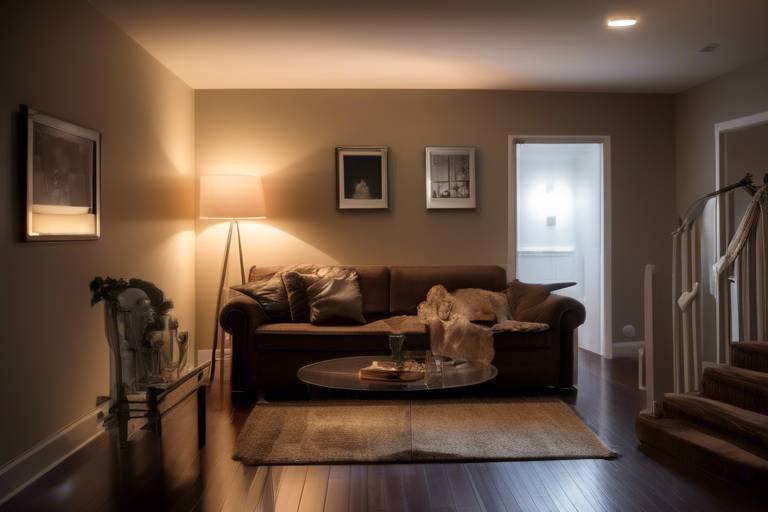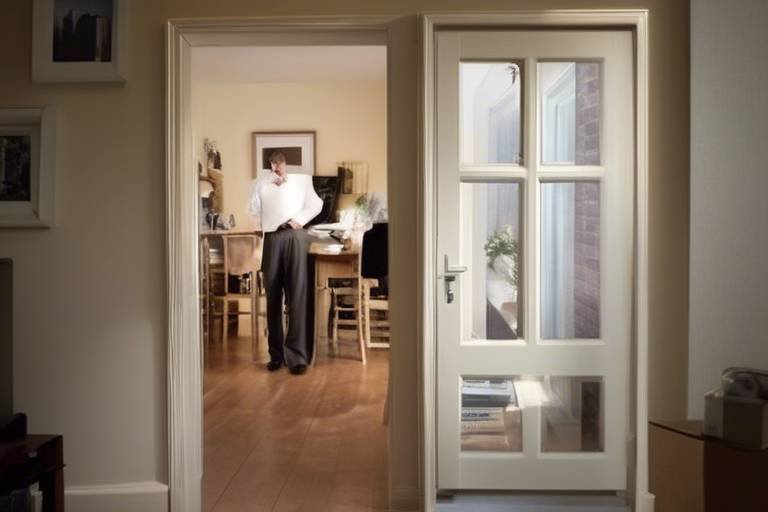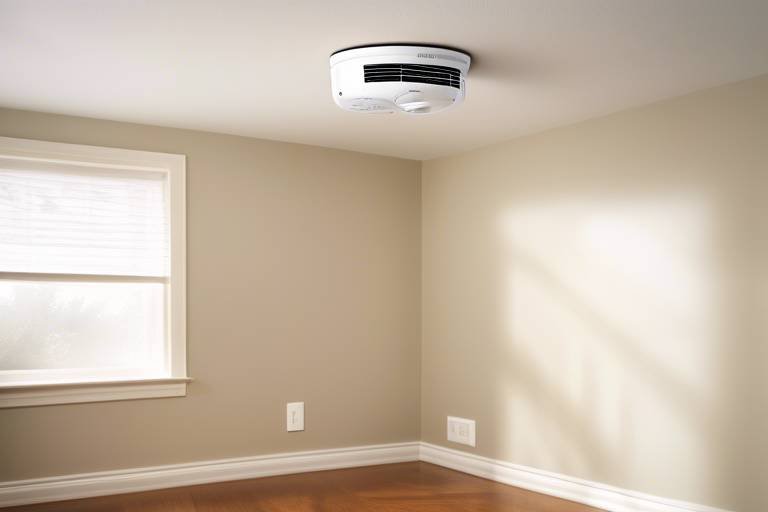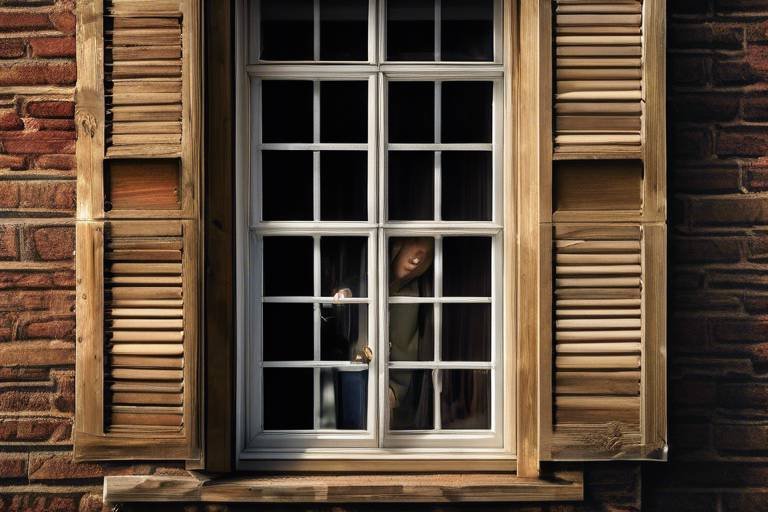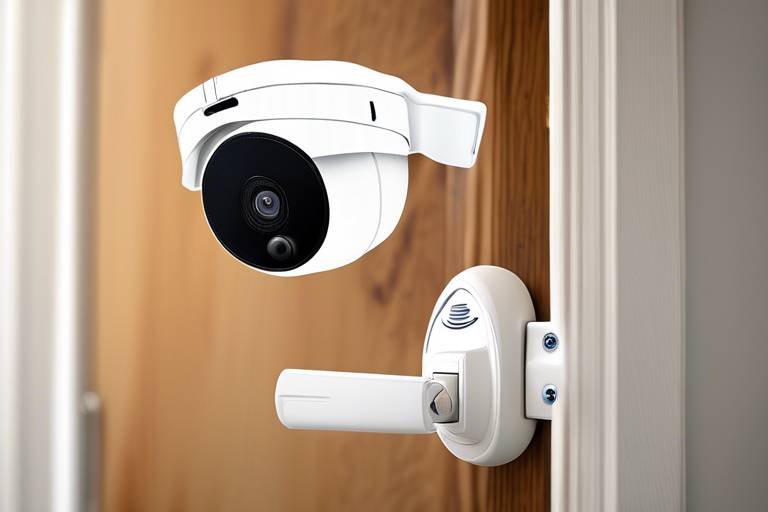How to Use Home Lighting for Better Security
In today's world, ensuring the safety of our homes has become more crucial than ever. One of the most effective yet often overlooked strategies for enhancing home security is through effective lighting. Lighting does not just illuminate your surroundings; it can also act as a powerful deterrent against potential intruders. By utilizing smart lighting solutions and understanding how to strategically place lights around your home, you can create a safer environment for your family. Let's dive into how home lighting can transform your security measures.
Outdoor lighting plays a crucial role in home security. Imagine walking up to a home that is completely dark; it feels eerie, right? Now picture the same home brightly lit. The difference is striking! Well-lit exteriors not only deter potential intruders but also create a welcoming atmosphere for residents and visitors alike. When areas around your home are illuminated, it becomes significantly harder for intruders to hide, thus making your property less appealing to them. Moreover, proper outdoor lighting can help you navigate safely around your property at night, reducing the risk of accidents.
When it comes to security lighting, there are various options available, each offering unique benefits that can enhance the overall safety of your property. From motion sensor lights that react to movement to floodlights that cover large areas, these lighting solutions can be tailored to meet your specific needs. Let's take a closer look at some of the most effective types of security lighting.
Motion sensor lights are an excellent way to alert homeowners of movement in their vicinity. Imagine sitting in your living room when suddenly, the outside lights flicker on as someone approaches your home. Not only do these lights provide instant illumination, but they also act as a deterrent to potential intruders who may be startled by the sudden brightness. This feature can be particularly useful in high-risk areas such as driveways, backyards, and entry points.
One of the standout benefits of motion sensors is their ability to save energy and reduce costs. Since they activate only when movement is detected, you won’t have to worry about leaving lights on all night. Additionally, the instant visibility they provide can significantly help in preventing crime. When a would-be intruder realizes they’ve been spotted, they are likely to reconsider their actions.
Proper placement is key for maximizing the effectiveness of motion sensors. Consider installing them at strategic locations such as:
- Entry points like doors and windows
- Driveways and garages
- Dark corners of your yard
By positioning them in these areas, you can ensure that any movement is detected promptly, thereby enhancing your home security.
Floodlights are another powerful tool in your security lighting arsenal. These lights provide broad illumination, making them ideal for covering large areas. Their brightness can deter intruders and enhance visibility during nighttime hours. Imagine a floodlight illuminating your entire backyard; it not only lights up the space but also makes it nearly impossible for anyone to sneak around undetected. Investing in quality floodlights can significantly contribute to your overall home security strategy.
With advancements in technology, smart lighting solutions now allow homeowners to control their outdoor lights remotely. This feature can provide added security by simulating occupancy, even when residents are away. Imagine being on vacation and having the ability to turn your lights on and off from your smartphone! This not only gives potential intruders the impression that someone is home, but it also allows you to respond quickly to any suspicious activity.
Automated lighting systems can be programmed to turn on and off at specific times, creating the illusion of someone being home. This simple yet effective strategy can deter potential burglars who may be scouting your property. By using a mix of timers and smart lighting, you can maintain a consistent presence in your home, even when you're not there.
Integrating smart home devices with your lighting systems can take your security measures to the next level. By connecting cameras and alarms, homeowners can receive alerts and monitor their property in real-time. This interconnectedness allows you to keep an eye on your home from anywhere, providing peace of mind whether you’re at work or on vacation.
- How can I choose the right type of security lighting for my home? Consider the specific areas you want to illuminate and the level of security you need. Motion sensors are great for entry points, while floodlights work well for larger outdoor spaces.
- Are smart lighting solutions worth the investment? Absolutely! Smart lighting not only enhances security but also offers convenience and energy savings.
- Can I install security lights myself? Yes, many security lights are designed for easy installation, but if you're unsure, it may be wise to consult a professional.

Understanding the Importance of Outdoor Lighting
When it comes to home security, one of the most overlooked aspects is outdoor lighting. Many homeowners underestimate how effective a well-lit exterior can be in keeping their property safe. Imagine a dark, shadowy yard where potential intruders can hide; now picture that same yard illuminated with bright, welcoming lights. Which scenario do you think is more inviting for a burglar? That's right! A well-lit home not only deters crime, but also provides a sense of safety for those who live there and their visitors.
Outdoor lighting serves multiple purposes that extend beyond just aesthetics. For starters, it enhances visibility, making it easier for residents to navigate their properties at night. Think about it: have you ever tripped over a garden hose or stumbled on uneven pavement in the dark? With proper lighting, these hazards become much less of an issue. Moreover, well-placed lights can highlight the beauty of your landscaping, creating a warm and inviting atmosphere that can be enjoyed during evening gatherings.
But let’s get back to security. Studies have shown that homes with adequate outdoor lighting are significantly less likely to be targeted by burglars. Why? Because when a property is brightly lit, it leaves little room for intruders to hide. In fact, according to a survey conducted by the International Association of Chiefs of Police, nearly 60% of burglars stated that they would avoid a home that is well-lit. This statistic alone underscores the importance of investing in outdoor lighting as a proactive measure for home security.
Additionally, outdoor lighting can serve as a strong visual deterrent. A well-lit home sends a message that the residents are vigilant and care about their safety. This can be particularly effective in neighborhoods where crime rates are on the rise. When potential intruders see a house that is bright and inviting, they are more likely to think twice before attempting to break in. In this sense, outdoor lighting acts as a first line of defense against crime.
Incorporating different types of outdoor lighting can further enhance security. For example, pathway lights not only guide guests safely to your door but also illuminate areas that could otherwise be dark and secluded. Similarly, floodlights can cover large areas, ensuring that no corner of your property is left in the shadows. By combining various lighting solutions, you can create a layered approach to security that is both functional and aesthetically pleasing.
In conclusion, outdoor lighting is not just about making your home look good; it’s a crucial element in enhancing your home’s security. By investing in quality lighting solutions, you can deter potential intruders, create a safer environment for your family, and enjoy your outdoor spaces to the fullest. So, why wait? Light up your home and take the first step toward a more secure living space!

Types of Security Lighting
When it comes to safeguarding your home, understanding the various is essential. Each type serves a unique purpose, and knowing which one to use can significantly enhance your home's defense against intruders. Let’s dive into the different options available, so you can make an informed choice that best suits your needs.
First on the list are motion sensor lights. These innovative fixtures are designed to detect movement and automatically activate when someone approaches. Imagine this: you’re coming home late one night, and as you step onto your driveway, the lights suddenly flood the area with brightness. Not only does this provide you with a clear view of your surroundings, but it also sends a clear message to any potential intruder that they’ve been spotted. The surprise factor here is huge! Not to mention, motion sensor lights are incredibly energy-efficient since they only operate when needed.
Next up, we have floodlights. These powerful lights are perfect for illuminating large areas, making them ideal for driveways, backyards, and other expansive spaces. Think of floodlights as the spotlight on a stage—they bring everything into focus. Their intense brightness can discourage unwanted visitors, as it leaves no dark corners for them to hide in. Plus, when paired with a motion sensor, floodlights can create an effective security duo that not only lights up the night but also surprises any would-be criminals.
Another option worth considering is solar-powered lights. These eco-friendly solutions harness the sun's energy, making them a cost-effective choice for homeowners looking to enhance their security without increasing their electricity bills. Solar lights can be placed anywhere around your property, from pathways to garden areas, and they automatically charge during the day to provide illumination at night. It’s like having a little sunbeam watching over your home!
For those who prefer a more integrated approach, smart lighting systems are the way to go. These systems allow you to control your outdoor lights remotely via smartphone apps. Imagine being on vacation and receiving a notification that someone is lurking around your property. With a few taps on your phone, you can turn on your lights, creating the illusion that someone is home. This technology not only enhances your security but also provides peace of mind, knowing that you have control over your home’s lighting from anywhere in the world.
Lastly, let’s not forget about pathway lights. While they may seem simple, these lights serve a dual purpose: they illuminate walkways for safe navigation and also act as a deterrent against trespassers. When your pathways are well-lit, it not only makes it difficult for intruders to approach unnoticed but also creates a welcoming atmosphere for guests. After all, who doesn’t love a beautifully lit path leading up to their front door?
In conclusion, choosing the right type of security lighting can make a significant difference in your home’s safety. Whether you opt for motion sensor lights, floodlights, solar-powered options, smart systems, or pathway lights, each type offers unique benefits that contribute to a more secure living environment. By combining these different types of lighting, you can create a comprehensive security strategy that keeps your home safe and sound.
- What is the best type of security lighting for my home? - The best type depends on your specific needs, but a combination of motion sensor lights and floodlights is often recommended for maximum effectiveness.
- Are solar-powered lights effective for security? - Yes, solar-powered lights are effective, especially when placed in areas that receive ample sunlight. They are eco-friendly and cost-effective.
- Can smart lighting systems really deter intruders? - Absolutely! Smart lighting systems can simulate occupancy, making it appear as though someone is home, which can deter potential burglars.

Motion Sensor Lights
When it comes to enhancing the security of your home, are like having an extra pair of eyes watching over your property. These ingenious devices are designed to detect movement and automatically illuminate the area, creating a well-lit environment that can significantly deter unwanted visitors. Imagine walking down a dark path and, suddenly, a light flickers on as you approach. That moment of surprise can be enough to send a potential intruder packing!
One of the most appealing aspects of motion sensor lights is their ability to provide instant visibility without requiring constant illumination. This not only saves energy but also reduces your electricity bills. Why waste power lighting up your entire yard when you can have lights that only activate when someone is nearby? This feature makes them an eco-friendly choice, aligning with modern sustainability goals while enhancing security.
But it's not just about saving energy; the benefits of these lights extend far beyond that. They act as a psychological barrier for would-be intruders. When a light suddenly turns on, it can startle them, making them think twice about their actions. Think of motion sensor lights as your home's first line of defense, providing both illumination and a sense of security for you and your family.
For optimal effectiveness, the placement of motion sensor lights is crucial. Ideally, you should install them at key locations around your property, such as:
- Front and back doors
- Driveways
- Garages
- Dark corners of your yard
By strategically positioning these lights, you can ensure that any movement is detected, and the area is illuminated, reducing the chances of a successful break-in.
In summary, motion sensor lights are not just a trend; they are a practical solution for home security. By providing instant illumination, conserving energy, and acting as a deterrent, they play a vital role in keeping your home safe. So, if you haven't considered installing them yet, now might be the perfect time to light up your security!
Q1: How do motion sensor lights work?
A1: Motion sensor lights use infrared sensors to detect movement. When a person or object moves within the sensor's range, the light turns on automatically.
Q2: Can motion sensor lights be adjusted?
A2: Yes, most motion sensor lights come with adjustable sensitivity settings, allowing you to customize how easily they detect movement.
Q3: Are motion sensor lights energy-efficient?
A3: Absolutely! Since they only activate when needed, motion sensor lights can significantly reduce energy consumption compared to traditional lighting.
Q4: Where should I place my motion sensor lights?
A4: Ideal locations include entry points, driveways, and any dark areas around your property that could benefit from added illumination.

Benefits of Motion Sensors
When it comes to enhancing your home security, motion sensor lights are like having an extra set of eyes watching over your property. Imagine a silent guardian that springs into action the moment it detects movement. This is not just a fantasy; it’s the reality of what motion sensors can offer. One of the most significant advantages of these lights is their ability to save energy. Unlike traditional lighting that stays on all night, motion sensors activate only when they detect movement, which means you’re not wasting electricity on lights that serve no purpose when no one is around.
Moreover, the instant visibility provided by motion sensors can be a game-changer when it comes to crime prevention. Picture this: a would-be intruder approaches your home, and suddenly, bright lights flood the area. The unexpected illumination can startle them, making them think twice about their intentions. This immediate reaction not only protects your property but also enhances your peace of mind. In fact, studies have shown that well-lit areas significantly reduce the likelihood of criminal activity.
Another fantastic benefit of motion sensors is their versatility. They can be installed in various locations around your home, including:
- Front and back doors
- Driveways
- Garages
- Paths and walkways
By strategically placing these lights, you create a well-lit environment that discourages unwanted visitors. It’s like setting a stage where the unwelcome guests are left in the dark—literally!
Let’s not forget about the cost-effectiveness of these lights. By reducing energy consumption, you can save money on your utility bills. Plus, the peace of mind that comes from knowing your home is safeguarded is priceless. In a world where security is paramount, investing in motion sensor lights can be one of the most practical decisions you make for your home.
In summary, the benefits of motion sensors are clear: they save energy, deter crime, are versatile in placement, and can lead to cost savings. By incorporating these lights into your security strategy, you’ll not only enhance the safety of your home but also enjoy the convenience and efficiency they bring. So why wait? Illuminate your space and keep those intruders at bay!
1. How do motion sensors work?
Motion sensors detect movement through various technologies, such as passive infrared (PIR) sensors, which sense changes in heat, or microwave sensors, which detect movement through radar waves. When movement is detected, the sensor activates the light.
2. Can I install motion sensor lights myself?
Yes, many motion sensor lights are designed for easy installation and can be set up by homeowners without professional help. However, if you're not comfortable with electrical work, it's best to hire a professional electrician.
3. Are motion sensor lights weatherproof?
Most outdoor motion sensor lights are designed to be weatherproof and can withstand rain, snow, and varying temperatures. Always check the specifications before purchasing to ensure they are suitable for your climate.
4. Will motion sensor lights scare off all intruders?
While motion sensor lights can deter many intruders by increasing visibility and creating a sense of alertness, they are not a foolproof solution. It's best to combine them with other security measures, such as alarms and surveillance cameras.

Installation Tips for Motion Sensors
This article explores effective strategies for utilizing home lighting to enhance security. Learn how proper lighting can deter intruders and create a safer environment for your home and family.
Outdoor lighting plays a crucial role in home security. Well-lit exteriors can deter potential intruders and provide a sense of safety for residents and visitors alike.
There are various types of security lighting options available. From motion sensor lights to floodlights, each type has unique benefits that can enhance the overall security of your property.
Motion sensor lights are an effective way to alert homeowners of movement. These lights can automatically turn on when someone approaches, providing both illumination and a deterrent to potential intruders.
Motion sensors save energy and reduce costs by only activating when needed. They also provide instant visibility, which can help prevent crime by startling would-be intruders.
Proper placement is key for motion sensors. You want to ensure that they are installed in areas where they can detect movement effectively. Think of your home as a fortress; just as you wouldn’t leave the gates unguarded, you shouldn’t leave your entry points unmonitored. Here are some crucial tips for installation:
- Strategic Locations: Install motion sensors at all entry points, including doors and windows, as well as along pathways leading to your home. This ensures that any movement is detected before an intruder reaches your door.
- Height Matters: Position the sensors at a height of about 6 to 8 feet. This height allows them to cover a broader area while minimizing false alarms caused by small animals.
- Adjust the Sensitivity: Most motion sensors come with adjustable sensitivity settings. Test these settings to find the right balance that detects human movement while ignoring smaller disturbances.
- Consider the Environment: Be mindful of any obstructions like trees or fences that might block the sensor’s view. Also, avoid placing them in direct sunlight, which can cause them to malfunction.
- Test the Coverage: After installation, walk through the area to ensure the sensors activate as expected. Adjust their angles if necessary to maximize coverage.
By following these tips, you can ensure that your motion sensors are not just decorative but functional guardians of your home, ready to spring into action when needed.
Floodlights offer broad illumination, making them ideal for covering large areas. Their brightness can deter intruders and enhance visibility during nighttime hours, contributing to overall home security.
Smart lighting technology allows homeowners to control their outdoor lights remotely. This feature can provide added security by simulating occupancy, even when residents are away.
Automated lighting systems can be programmed to turn on and off at specific times. This creates the illusion of someone being home, which can deter potential burglars.
Integrating smart home devices with lighting systems enhances security. By connecting cameras and alarms, homeowners can receive alerts and monitor their property in real-time.
Q: How do motion sensor lights work?
Motion sensor lights use infrared technology to detect body heat. When someone approaches, the sensor triggers the light, illuminating the area.
Q: Can I use motion sensors indoors?
Absolutely! Motion sensors can be used indoors to enhance security in areas like hallways, garages, and basements.
Q: What should I do if my motion sensor light keeps turning on?
Check for any obstructions that might be triggering the sensor, such as moving branches or pets. Adjusting the sensitivity settings can also help reduce false alarms.
Q: Are smart lighting systems expensive?
While the initial investment may be higher than traditional lighting, the long-term savings on energy bills and the added security can make them worthwhile.

Floodlights and Security
When it comes to enhancing the security of your home, floodlights are a game changer. These powerful lights are designed to illuminate large areas, making them ideal for driveways, backyards, and entry points. Imagine walking down a dark street and suddenly being bathed in bright light—it's enough to make anyone think twice before approaching. That's the magic of floodlights! They not only light up your surroundings but also serve as a strong deterrent against potential intruders.
Floodlights are particularly effective because they can cover a wide area without leaving dark spots where intruders might hide. Their brightness can be intimidating, making it clear that your property is well-monitored. Furthermore, floodlights can be equipped with motion sensors, which means they will activate when someone steps onto your property. This sudden burst of light can startle would-be burglars, giving them a reason to reconsider their plans. After all, who wants to be caught in the spotlight?
Another significant advantage of floodlights is their versatility. They come in various sizes and brightness levels, allowing homeowners to choose the best option for their specific needs. Whether you want a subtle glow to light up a pathway or a powerful beam to cover a large backyard, there's a floodlight for every situation. Additionally, modern floodlights can be integrated with smart home systems, enabling you to control them remotely through your smartphone. This means you can turn them on and off or adjust their brightness even when you're not home, creating an illusion of occupancy that can deter intruders.
In terms of installation, floodlights should be strategically placed to maximize their effectiveness. Here are some key areas to consider:
- Near entry points like doors and windows
- Along pathways leading to your home
- In your backyard, especially near garages or sheds
- At the corners of your property for broader coverage
Ultimately, the presence of floodlights not only enhances the security of your home but also provides peace of mind for you and your family. Knowing that your property is well-lit and monitored can significantly reduce anxiety about potential break-ins. So, if you haven’t considered adding floodlights to your home security plan yet, it’s time to shine a light on this effective strategy!
Q: How bright should my floodlights be for security purposes?
A: Generally, a brightness of around 700 to 1000 lumens is recommended for effective security lighting. However, the specific brightness may vary based on the area you need to cover.
Q: Can floodlights be used with smart home systems?
A: Absolutely! Many modern floodlights are compatible with smart home systems, allowing you to control them remotely and integrate them with other security devices.
Q: How do I prevent floodlights from being triggered by animals?
A: Adjust the sensitivity settings of your motion sensors and consider positioning the lights higher off the ground to reduce false alarms caused by small animals.
Q: Are there energy-efficient options for floodlights?
A: Yes! LED floodlights are an excellent choice as they consume less energy and have a longer lifespan compared to traditional halogen or incandescent bulbs.

Smart Lighting Solutions
In today’s tech-savvy world, have revolutionized the way we think about home security. Imagine being able to control your outdoor lights with just a tap on your smartphone, or even better, having them respond automatically to your presence or absence. This is not just a luxury; it’s a practical way to enhance the safety of your home. With smart lighting, you can create an illusion of occupancy, making it seem like someone is always home, even when you’re away enjoying a vacation or a weekend getaway.
One of the standout features of smart lighting is its ability to be programmed to turn on and off at specific times. This means you can set your porch lights to illuminate at dusk and turn off at dawn, or have them mimic your usual patterns when you’re away. By creating a consistent lighting schedule, you can effectively deter potential burglars who often scout neighborhoods for signs of unoccupied homes. Think of it as a virtual security guard that operates silently in the background, keeping your property safe.
Moreover, integrating smart lighting with other home automation devices can take your security to the next level. For instance, when your security camera detects movement, it can trigger your outdoor lights to turn on, illuminating the area and alerting you to any unusual activity. This interconnectedness not only enhances your security but also gives you peace of mind. You can monitor your home in real-time, receiving alerts directly to your phone, ensuring you’re always in the loop.
To illustrate how these smart lighting systems work, let’s take a closer look at some features you might consider when choosing a system:
| Feature | Description |
|---|---|
| Remote Control | Control your lights from anywhere using a smartphone app. |
| Scheduling | Set timers for your lights to mimic your daily routine. |
| Integration | Connect with other smart devices like cameras and alarms. |
| Voice Control | Use voice commands via smart assistants to control your lights. |
As you can see, the benefits of smart lighting extend beyond mere convenience. They provide a robust layer of security that can be tailored to your lifestyle. If you’re considering upgrading your home security, investing in smart lighting solutions is a step in the right direction. It’s like adding a high-tech shield around your home, ensuring that you and your loved ones feel safe and secure at all times.
- Can I install smart lighting myself? Yes, many smart lighting systems are designed for easy installation and can be set up without professional help.
- Do smart lights work during a power outage? Most smart lights require power to function, but some systems have backup options that can keep them operational during outages.
- Are smart lighting systems expensive? While initial costs may vary, the long-term savings on energy bills and increased security can make them a worthwhile investment.
- Can I control smart lights when I’m away from home? Absolutely! Most smart lighting systems allow for remote access via mobile apps.

Automated Lighting Systems
Automated lighting systems are revolutionizing the way we think about home security. Imagine being able to control your lights from anywhere in the world with just a tap on your smartphone. This technology not only enhances convenience but also significantly boosts your home's security profile. By programming your lights to turn on and off at specific times, you can create the illusion that someone is always home, which is a powerful deterrent against potential burglars.
But how exactly do these systems work? Most automated lighting solutions can be integrated with smart home devices, allowing for seamless control and monitoring. For instance, you can set your lights to mimic your daily routine. If you typically come home at 6 PM, you can program the lights to turn on at that time, creating a welcoming atmosphere and signaling to any would-be intruders that your home is occupied.
Additionally, many automated lighting systems come equipped with features like randomization. This means that your lights can turn on at different times each day, making it even harder for potential intruders to predict when your home is vacant. It’s like having an invisible guard that keeps watch over your property, making it a less appealing target for crime.
Furthermore, integrating these systems with other smart devices can enhance your security even further. For example, you can connect your automated lighting to motion sensors or security cameras. When the motion sensor detects movement, it can trigger the lights to turn on, illuminating the area and alerting you to any unusual activity. This combination of technologies creates a comprehensive security solution that not only protects your home but also gives you peace of mind.
In terms of installation, most automated lighting systems are user-friendly and can be set up without professional help. However, for those who prefer a more sophisticated setup, hiring a professional can ensure that everything is installed correctly and optimized for your specific needs. Remember, the goal is to create a system that works for you, providing both security and convenience.
In summary, automated lighting systems are an invaluable addition to any home security strategy. They offer flexibility, control, and peace of mind, allowing homeowners to feel secure even when they are away. With the right setup, you can transform your home into a fortress, all while enjoying the modern conveniences that technology has to offer.
- How do automated lighting systems work? Automated lighting systems can be programmed to turn on and off at specific times or controlled remotely via a smartphone app.
- Can I integrate my lighting system with other smart devices? Yes! Most automated lighting systems can be connected to motion sensors, cameras, and alarms for enhanced security.
- Do I need professional installation for automated lighting? While many systems are user-friendly and can be installed by homeowners, hiring a professional can ensure optimal setup and performance.
- Will automated lighting save me money on my energy bill? Yes, by using timers and sensors, automated lighting can help reduce energy consumption by ensuring lights are only on when needed.

Integrating Smart Devices
Integrating smart devices into your home lighting system is like adding a high-tech security blanket to your property. Imagine being able to control your lights from anywhere in the world, all through your smartphone or tablet. This level of control not only enhances your convenience but also significantly boosts your home security. When you think about it, the ability to manage your lighting remotely can create a powerful illusion of occupancy, making it less likely for intruders to target your home.
One of the most effective ways to integrate smart devices is through smart lighting systems that can be programmed to turn on and off at specific times. This feature allows you to simulate your presence at home, especially when you’re away on vacation or at work. For instance, you could set your porch light to turn on at dusk and your living room lights to flicker on and off in the evening. This simple trick can make it look like someone is home, thereby deterring potential burglars who are scouting for easy targets.
Moreover, many smart lighting systems can be connected with other smart home devices, such as security cameras and alarms. This integration creates a comprehensive security network that offers real-time monitoring. For example, if your security camera detects motion, it can trigger your outdoor lights to turn on automatically. This sudden burst of light not only illuminates the area but also alerts you to potential threats, giving you time to react. It’s like having a personal security guard that never sleeps!
When considering which smart devices to integrate, look for those that offer compatibility with your existing home automation system. Most modern systems allow for seamless integration, enabling you to control everything from a single app. Here are some popular smart devices to consider:
- Smart Bulbs: These can be controlled remotely and programmed to change colors or brightness.
- Smart Plugs: Use these to control any lamp or light fixture plugged into them.
- Smart Cameras: Monitor your property and receive alerts directly to your phone.
- Smart Doorbells: See who’s at your door and communicate with them, even when you’re not home.
Ultimately, the integration of smart devices into your home lighting system not only enhances security but also adds a layer of convenience that traditional systems simply can’t match. Whether you’re at home or away, the peace of mind that comes from knowing you can monitor and control your lights is invaluable. So, why not take the plunge and embrace the future of home security? Your home—and your family—will thank you for it!
Q: How can I start integrating smart devices into my home lighting?
A: Begin by researching compatible smart lighting systems and devices that work with your existing home automation setup. Consider starting with smart bulbs or plugs for easy integration.
Q: Are smart devices expensive to maintain?
A: While the initial investment can be higher than traditional lighting, many smart devices save energy and reduce utility bills in the long run, making them cost-effective.
Q: Can I control my smart lights when I'm not at home?
A: Yes! Most smart lighting systems allow you to control your lights remotely through a smartphone app, providing flexibility and convenience.
Q: Do I need a specific hub to connect my smart devices?
A: Some smart devices require a hub for connectivity, while others can connect directly to your Wi-Fi network. Check the specifications before purchasing.
Frequently Asked Questions
- How does outdoor lighting improve home security?
Outdoor lighting significantly enhances home security by illuminating dark areas around your property. This visibility makes it harder for intruders to approach unnoticed, while also providing a safer environment for you and your family. Think of it as a spotlight on a stage—when the lights are on, everyone can see what's happening!
- What are the best types of security lighting for my home?
The best types of security lighting include motion sensor lights and floodlights. Motion sensor lights activate when they detect movement, startling potential intruders and alerting homeowners. Floodlights, on the other hand, provide broad illumination, covering large areas and making your property less appealing to burglars.
- Are motion sensor lights energy-efficient?
Absolutely! Motion sensor lights are designed to save energy by only turning on when needed. This means you won’t be wasting electricity on lights that stay on all night. It’s like having a personal assistant who only works when you need them!
- Where should I install motion sensor lights?
For maximum effectiveness, install motion sensor lights at key entry points such as the front and back doors, garages, and driveways. Placing them in these strategic locations ensures that they can detect movement as soon as someone approaches your home.
- What are smart lighting solutions?
Smart lighting solutions allow you to control your outdoor lights remotely using your smartphone or smart home devices. This feature is fantastic for simulating occupancy, making it look like someone is home even when you’re away, which can help deter burglars.
- How do automated lighting systems work?
Automated lighting systems can be programmed to turn on and off at specific times, creating the illusion that someone is home. This clever trick can deter potential intruders who might be watching your property for signs of occupancy.
- Can I integrate my lighting with other smart devices?
Yes! Integrating your lighting system with other smart devices like cameras and alarms enhances your home security. This setup allows you to receive real-time alerts and monitor your property from anywhere, giving you peace of mind whether you're at home or away.

